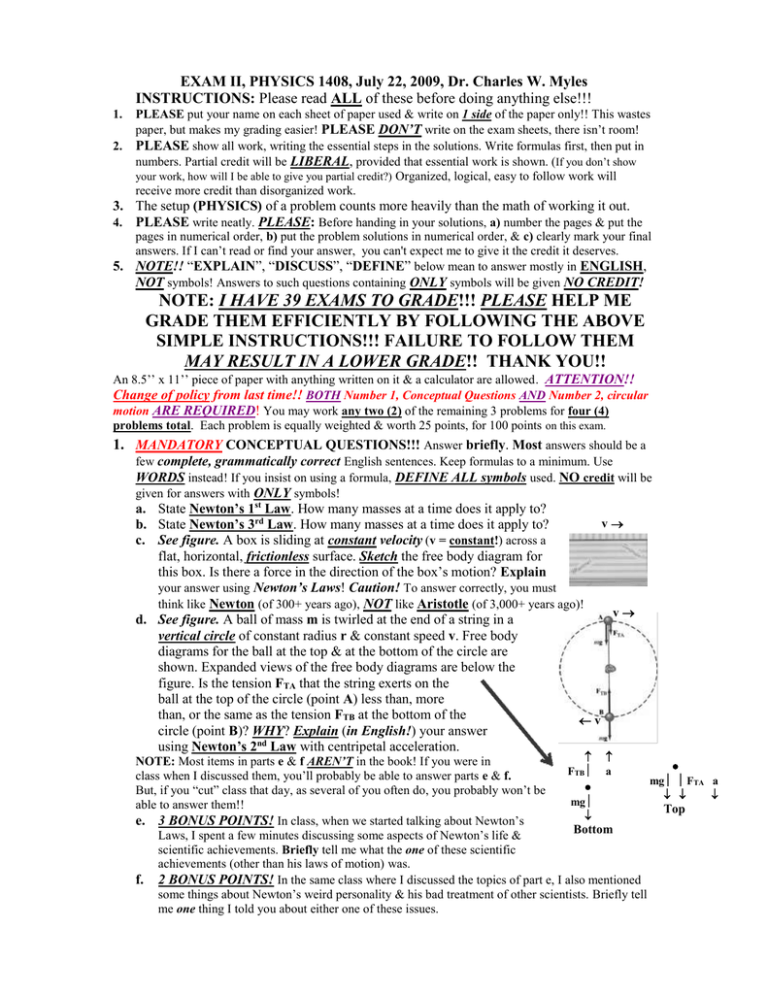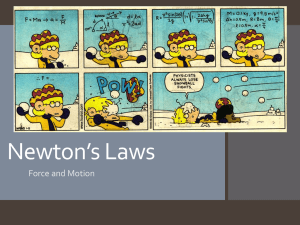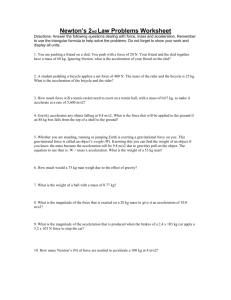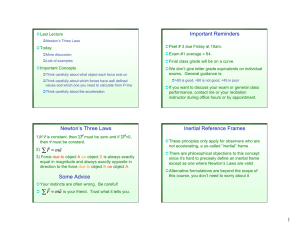EXAM II, PHYSICS 1408, July 22, 2009, Dr. Charles W.... INSTRUCTIONS: PLEASE
advertisement

EXAM II, PHYSICS 1408, July 22, 2009, Dr. Charles W. Myles INSTRUCTIONS: Please read ALL of these before doing anything else!!! 1. 2. PLEASE put your name on each sheet of paper used & write on 1 side of the paper only!! This wastes paper, but makes my grading easier! PLEASE DON’T write on the exam sheets, there isn’t room! PLEASE show all work, writing the essential steps in the solutions. Write formulas first, then put in numbers. Partial credit will be LIBERAL, provided that essential work is shown. (If you don’t show your work, how will I be able to give you partial credit?) Organized, logical, easy to follow work will receive more credit than disorganized work. 3. The setup (PHYSICS) of a problem counts more heavily than the math of working it out. 4. PLEASE write neatly. PLEASE: Before handing in your solutions, a) number the pages & put the pages in numerical order, b) put the problem solutions in numerical order, & c) clearly mark your final answers. If I can’t read or find your answer, you can't expect me to give it the credit it deserves. 5. NOTE!! “EXPLAIN”, “DISCUSS”, “DEFINE” below mean to answer mostly in ENGLISH, NOT symbols! Answers to such questions containing ONLY symbols will be given NO CREDIT! NOTE: I HAVE 39 EXAMS TO GRADE!!! PLEASE HELP ME GRADE THEM EFFICIENTLY BY FOLLOWING THE ABOVE SIMPLE INSTRUCTIONS!!! FAILURE TO FOLLOW THEM MAY RESULT IN A LOWER GRADE!! THANK YOU!! An 8.5’’ x 11’’ piece of paper with anything written on it & a calculator are allowed. ATTENTION!! Change of policy from last time!! BOTH Number 1, Conceptual Questions AND Number 2, circular motion ARE REQUIRED! You may work any two (2) of the remaining 3 problems for four (4) problems total. Each problem is equally weighted & worth 25 points, for 100 points on this exam. 1. MANDATORY CONCEPTUAL QUESTIONS!!! Answer briefly. Most answers should be a few complete, grammatically correct English sentences. Keep formulas to a minimum. Use WORDS instead! If you insist on using a formula, DEFINE ALL symbols used. NO credit will be given for answers with ONLY symbols! a. State Newton’s 1st Law. How many masses at a time does it apply to? v b. State Newton’s 3rd Law. How many masses at a time does it apply to? c. See figure. A box is sliding at constant velocity (v = constant!) across a flat, horizontal, frictionless surface. Sketch the free body diagram for this box. Is there a force in the direction of the box’s motion? Explain your answer using Newton’s Laws! Caution! To answer correctly, you must think like Newton (of 300+ years ago), NOT like Aristotle (of 3,000+ years ago)! v d. See figure. A ball of mass m is twirled at the end of a string in a vertical circle of constant radius r & constant speed v. Free body diagrams for the ball at the top & at the bottom of the circle are shown. Expanded views of the free body diagrams are below the figure. Is the tension FTA that the string exerts on the ball at the top of the circle (point A) less than, more than, or the same as the tension FTB at the bottom of the v circle (point B)? WHY? Explain (in English!) your answer using Newton’s 2nd Law with centripetal acceleration. NOTE: Most items in parts e & f AREN’T in the book! If you were in F a TB class when I discussed them, you’ll probably be able to answer parts e & f. mg FTA a But, if you “cut” class that day, as several of you often do, you probably won’t be mg able to answer them!! Top e. 3 BONUS POINTS! In class, when we started talking about Newton’s Bottom Laws, I spent a few minutes discussing some aspects of Newton’s life & scientific achievements. Briefly tell me what the one of these scientific achievements (other than his laws of motion) was. f. 2 BONUS POINTS! In the same class where I discussed the topics of part e, I also mentioned some things about Newton’s weird personality & his bad treatment of other scientists. Briefly tell me one thing I told you about either one of these issues. 2. See figure. MANDATORY CIRCULAR MOTION PROBLEM!!! A Ferris wheel moves in a vertical circle of radius r = 12 m at a constant speed v = 6 m/s. A rider of mass m = 55 kg is sitting in one of the cars. This person experiences a normal force FN due to the car seat pushing upward on their body. The free body diagrams for the rider at the top and at the bottom are shown in the figure. The normal force is labeled FN at both the top and the bottom. However, this does NOT imply that FN necessarily has the same numerical value at the two places (it might or it might not)! Part of this problem is to calculate FN at the two places! a. Calculate the period of the circular motion of the Ferris wheel. b. Calculate the centripetal acceleration experienced by the rider. c. Calculate the centripetal “force” on the rider. d. Use Newton’s 2nd Law with centripetal acceleration to calculate the normal force FN between the rider and the car seat at the top of the ride. e. Use Newton’s 2nd Law with centripetal acceleration to calculate the normal force FN between the rider and the car seat at the bottom of the ride. f. 5 BONUS POINTS!! Is the normal force FN found in parts d and e equal and opposite to the rider’s weight? WHY or WHY not? Explain this with Newton’s Laws. Use English words to answer this, NOT symbols! NOTE: WORK ANY TWO (2) OF PROBLEMS 3., 4., or 5.!!!!! 3. See figure. Two people are giving a child a sled ride on the snow. The ground the sled rides on is flat & horizontal(!) The combined mass of the child & sled is m = 35 kg. The people pull with equal forces FT1 = FT2 = 60 N, a which make equal angles θ = 35° with respect to the forward FT2 direction. The acceleration a is in the forward direction (to the left θ Ff in the figure). There is a friction force Ff between the sled & the θ snow, acting in the opposite direction of the motion. The coefficient FT1 of kinetic friction between the sled & the snow is μk = 0.21. To NOTE!! solve this problem, use the x & y axes shown. (Hint: Taking The ground in this figure is POSITIVE x to the left in the figure will make things easier! horizontal & perpendicular to NOTE! The x & y directions in the figure are in a plane parallel to the both the weight mg & the normal ground! This means obviously that the y-direction in the figure is NOT force FN! the vertical direction!) a. Calculate the x & y components of the forces FT1 & FT2. b. Calculate the weight of the child + sled & the normal force FN the ground produces on them. Is FN equal (& oppositely directed) to the weight? If so, why? Justify your answer using Newton’s 2nd Law perpendicular to the ground. (Hint: Note again that the direction perpendicular to the ground IS NOT the y direction in the figure, which is horizontal! Since both the normal force FN that the ground produces on the child + sled and their combined weight mg are vertical vectors, their directions are perpendicular to the ground or perpendicular to the plane of the figure. c. Calculate the friction force Ff that the sled experiences as it moves to the left. d. Use Newton’s 2nd Law to find the acceleration a experienced by the sled + child. What forces cause this acceleration? NOTE: WORK ANY TWO (2) OF PROBLEMS 3., 4., or 5.!!!!! 4. See figure. Two masses (m1 = 14 kg and m2 = 18 kg) are connected by a massless cord FP and placed on a horizontal, frictionless θ surface. The two-mass system is pulled to FT the right by a force FP = 48 N using a cord that makes an angle of θ = 35º with the horizontal. The masses remain on the horizontal surface; there is no vertical motion. a. Sketch the free body diagrams for the two masses, properly labeling all forces. Be sure to include both horizontal and vertical forces. b. Calculate the horizontal & vertical components of the applied force FP. c. Calculate the normal force FN between m1 and the table. Is FN equal in size to (& opposite in direction) the weight? WHY or WHY NOT? Explain (in English!) your answer using Newton’s 2nd Law! d. The two unknowns in this problem are the acceleration, a, of the masses (the same for both) and the tension, FT, in the cord between them. By applying Newton’s 2nd Law to m1 and m2, find the two equations needed to solve for a and FT. Writing them in symbols, without substituting in numbers, will receive more credit than writing them with numbers substituted in! (That is, I DON’T want you to just write the abstract formula F = ma for the masses m1 & m2! I want you to explicitly write out the left side F for m1 & m2 in terms of the forces in this problem which are relevant to m1 & m2.) e. Using the equations from part d, calculate (find numerical values for) the acceleration a and the tension FT (in any order). NOTE: WORK ANY TWO (2) OF PROBLEMS 3., 4., or 5.!!!!! 5. See figure. Two masses, m1 = 24 kg & m2 = 33 kg, are a connected by a massless cord over a massless, frictionless m1 pulley. m1 sits on a flat, horizontal frictionless table & m2 FT hangs vertically. An unknown vertical force FP pulls downward on m2. This causes m1 to accelerate to the right with FT acceleration a = 7.5 m/s2 & m2 to accelerate downward with the FP same acceleration. m2 a. Sketch the free body diagrams for the two masses, properly labeling all forces. For m1, be sure to include the tension FT in the cord & also to include both horizontal & vertical (weights of both masses & normal force on m1) b. The two unknowns are the pulling force FP & the tension, FT, in the cord. By applying Newton’s 2nd Law to m1 & m2, find the two equations needed to solve for FP & FT. Writing these equations in symbols, without substituting in numbers, will receive more credit than writing them with numbers substituted in! (That is, I DON’T want you to just write the abstract formula F = ma for the masses m1 & m2! I want you to explicitly write out the left side F for m1 & m2 in terms of the forces in this problem which are relevant to m1 & m2.) c. Using the equations from part b, calculate the two unknown forces FP & FT. (Hint: The cord tension FT can’t possibly be equal to the weight m2g!! If that were true, then FP would simply be equal to m2a, which is WRONG for this problem!) d. If mass m1 starts from rest, calculate it’s velocity after t = 2.0 s. (Hint: The acceleration of m1 & m2 is given as a = 7.5 m/s2 which is clearly NOT equal to the gravitational acceleration g. If that were true, m2 would be in free fall, the tension in the cord FT would be zero and m1 would not move!) a




